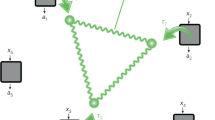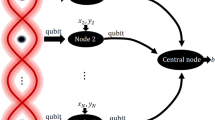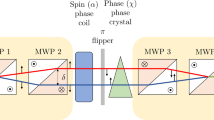Abstract
In any experimental setting, quantum physics provides the statistical distributions that the observed outcomes are expected to follow. The set formed by all these distributions contains the imprint of quantum theory and captures some of its core properties. So far, only partial explicit descriptions of this set have been found for Bell-type settings in which entangled states can be shared and measured by independent observers. Here we obtain the complete explicit and analytical description of a full set of quantum statistics in terms of its extremal points. This is made possible by finding all bipartite quantum states and pairs of binary measurements that can be self-tested, that is, reconstructed from empirical statistics only. Our description precisely reveals some of the extent and limitations of quantum theory.
This is a preview of subscription content, access via your institution
Access options
Access Nature and 54 other Nature Portfolio journals
Get Nature+, our best-value online-access subscription
$32.99 / 30 days
cancel any time
Subscribe to this journal
Receive 12 print issues and online access
$259.00 per year
only $21.58 per issue
Buy this article
- Purchase on SpringerLink
- Instant access to full article PDF
Prices may be subject to local taxes which are calculated during checkout



Similar content being viewed by others
Data availability
Data sharing is not applicable to this paper as no datasets were generated or analysed during the current study.
References
Clauser, J. F., Horne, M. A., Shimony, A. & Holt, R. A. Proposed experiment to test local hidden-variable theories. Phys. Rev. Lett. 23, 880 (1969).
Einstein, A., Podolsky, B. & Rosen, N. Can quantum-mechanical description of physical reality be considered complete? Phys. Rev. 47, 777 (1935).
Bell, J. S. On the Einstein Podolsky Rosen paradox. Phys. Phys. Fiz. 1, 195 (1964).
Bennett, C. H. & Brassard, G. Quantum cryptography: public key distribution and coin tossing. Theor. Comput. Sci. 560, 711 (2014).
Pironio, S. et al. Random numbers certified by Bell’s theorem. Nature 464, 1021 (2010).
Brunner, N., Cavalcanti, D., Pironio, S., Scarani, V. & Wehner, S. Bell nonlocality. Rev. Mod. Phys. 86, 419 (2014).
Born, M. Quantenmechanik der Stoßvorgänge. Z. Phys. 38, 803 (1926).
Cirel’son, B. S. Quantum generalizations of Bell’s inequality. Lett. Math. Phys. 4, 93 (1980).
Landau, L. J. Empirical two-point correlation functions. Found. Phys. 18, 449 (1988).
Masanes, L. Necessary and sufficient condition for quantum-generated correlations. Preprint at arxiv.org/abs/quant-ph/0309137 (2003).
Navascués, M., Pironio, S. & Acín, A. Bounding the set of quantum correlations. Phys. Rev. Lett. 98, 010401 (2007).
Skrzypczyk, P. & Cavalcanti, D. Semidefinite Programming in Quantum Information Science (IOP, 2023).
Mironowicz, P. Semi-definite programming and quantum information. J. Phys. A: Math. Theor. 57, 163002 (2024).
Tavakoli, A., Pozas-Kerstjens, A., Brown, P. & Araújo, M. Semidefinite programming relaxations for quantum correlations. Rev. Mod. Phys. 96, 045006 (2024).
Bhardwaj, A., Klep, I. & Magron, V. in Encyclopedia of Optimization (eds Pardalos, P. M. & Prokopyev, O. A.) 1–13 (Springer, 2022).
de Vicente, J. I. Simple conditions constraining the set of quantum correlations. Phys. Rev. A 92, 032103 (2015).
Scarani, V. The device-independent outlook on quantum physics. Acta Phys. Slovaca 62, 347 (2012).
Popescu, S. & Rohrlich, D. Generic quantum nonlocality. Phys. Lett. A 166, 293–297 (1992).
Pawłowski, M. et al. Information causality as a physical principle. Nature 461, 1101 (2009).
Miguel, N. & Harald, W. A glance beyond the quantum model. Proc. R. Soc. A: Math. Phys. Eng. Sci. 466, 881–890 (2010).
Fritz, T. et al. Local orthogonality as a multipartite principle for quantum correlations. Nat. Commun. 4, 2263 (2013).
Acín, A. et al. Device-independent security of quantum cryptography against collective attacks. Phys. Rev. Lett. 98, 230501 (2007).
Barreiro, J. T. et al. Demonstration of genuine multipartite entanglement with device-independent witnesses. Nat. Phys. 9, 559–562 (2013).
Moroder, T., Bancal, J.-D., Liang, Y.-C., Hofmann, M. & Gühne, O. Device-independent entanglement quantification and related applications. Phys. Rev. Lett. 111, 030501 (2013).
Nadlinger, D. P. et al. Experimental quantum key distribution certified by Bell’s theorem. Nature 607, 682 (2022).
Zhang, W. et al. A device-independent quantum key distribution system for distant users. Nature 607, 687 (2022).
Liu, W.-Z. et al. Toward a photonic demonstration of device-independent quantum key distribution. Phys. Rev. Lett. 129, 050502 (2022).
Tura, J. et al. Detecting nonlocality in many-body quantum states. Science 344, 1256 (2014).
Bravyi, S., Gosset, D. & König, R. Quantum advantage with shallow circuits. Science 362, 308 (2018).
Goh, K. T. et al. Geometry of the set of quantum correlations. Phys. Rev. A 97, 022104 (2018).
Rai, A., Duarte, C., Brito, S. & Chaves, R. Geometry of the quantum set on no-signaling faces. Phys. Rev. A 99, 032106 (2019).
Chen, K.-S. et al. Quantum correlations on the no-signaling boundary: self-testing and more. Quantum 7, 1054 (2023).
Barizien, V., Sekatski, P. & Bancal, J.-D. Custom Bell inequalities from formal sums of squares. Quantum 8, 1333 (2024).
Barizien, V. & Bancal, J.-D. Extremal Tsirelson inequalities. Phys. Rev. Lett. 133, 010201 (2024).
Rai, A. et al. Self-testing quantum states via nonmaximal violation in Hardy’s test of nonlocality. Phys. Rev. A 105, 052227 (2022).
Liu, Y., Chung, H. Y. & Ramanathan, R. (Almost-)quantum Bell inequalities and device-independent applications. Quantum 8, 1489 (2024).
Ishizaka, S. Necessary and sufficient criterion for extremal quantum correlations in the simplest Bell scenario. Phys. Rev. A 97, 050102 (2018).
Mikos-Nuszkiewicz, A. & Kaniewski, J. Extremal points of the quantum set in the CHSH scenario: conjectured analytical solution. Preprint at https://doi.org/10.1103/PhysRevA.108.012212 (2023).
Mayers, D. & Yao, A. Self testing quantum apparatus. Quantum Inf. Compt. 4, 273–286 (2004).
Šupiç, I. & Bowles, J. Self-testing of quantum systems: a review. Quantum 4, 337 (2020).
Ji, Z., Natarajan, A., Vidick, T., Wright, J. & Yuen, H. MIP* = RE. Commun. ACM 64, 131–138 (2021).
Magniez, F., Mayers, D., Mosca, M. & Ollivier, H. in Automata, Languages and Programming (eds Bugliesi, M. et al.) 72–83 (Springer, 2006).
Sekatski, P., Bancal, J.-D., Wagner, S. & Sangouard, N. Certifying the building blocks of quantum computers from Bell’s theorem. Phys. Rev. Lett. 121, 180505 (2018).
Reichardt, B. W., Unger, F. & Vazirani, U. Classical command of quantum systems. Nature 496, 456–460 (2013).
McKague, M. Interactive proofs for \({\mathsf{BQP}}\) via self-tested graph states. Theory Comput. 12, 1–42 (2016).
Coladangelo, A., Goh, K. T. & Scarani, V. All pure bipartite entangled states can be self-tested. Nat. Commun. 8, 15485 (2017).
Wang, Y., Wu, X. & Scarani, V. All the self-testings of the singlet for two binary measurements. New J. Phys. 18, 025021 (2016).
Le, T. P., Meroni, C., Sturmfels, B., Werner, R. F. & Ziegler, T. Quantum correlations in the minimal scenario. Quantum 7, 947 (2023).
Rockafellar, R. T. Convex Analysis (Princeton Univ. Press, 1970).
Donohue, J. M. & Wolfe, E. Identifying nonconvexity in the sets of limited-dimension quantum correlations. Phys. Rev. A 92, 062120 (2015).
Acknowledgements
We thank V. Scarani and A. Rai for their comments on the paper. We acknowledge funding from the Commissariat à l’Energie Atomique et aux Energies Alternatives.
Author information
Authors and Affiliations
Contributions
V.B. and J.-D.B. contributed equally to this work.
Corresponding author
Ethics declarations
Competing interests
The authors declare no competing interests.
Peer review
Peer review information
Nature Physics thanks the anonymous reviewers for their contribution to the peer review of this work.
Additional information
Publisher’s note Springer Nature remains neutral with regard to jurisdictional claims in published maps and institutional affiliations.
Supplementary information
Supplementary Information
Supplementary discussion.
Rights and permissions
Springer Nature or its licensor (e.g. a society or other partner) holds exclusive rights to this article under a publishing agreement with the author(s) or other rightsholder(s); author self-archiving of the accepted manuscript version of this article is solely governed by the terms of such publishing agreement and applicable law.
About this article
Cite this article
Barizien, V., Bancal, JD. Quantum statistics in the minimal Bell scenario. Nat. Phys. 21, 577–582 (2025). https://doi.org/10.1038/s41567-025-02782-3
Received:
Accepted:
Published:
Issue date:
DOI: https://doi.org/10.1038/s41567-025-02782-3
This article is cited by
-
The limits of quantum correlations
Nature Physics (2025)



